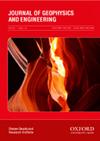浅层地壳结构的三维纵波模型,一种探测圈闭油气的补充方法:以伊朗西南部DehDasht地区为例
IF 1.7
3区 地球科学
Q3 GEOCHEMISTRY & GEOPHYSICS
引用次数: 0
摘要
局部纵波层析成像是研究地质复杂地区的一种有效方法,在这些地区,由于蒸发沉积厚度大,地震勘探方法不适合揭示浅层地壳非均质性。尽管伊朗西南部富盐的DehDasht地区地质特征复杂,但我们使用了一个临时地震台网(在2016年10月18日至2017年7月1日期间部署)记录的bb1011000个微地震事件,根据首次到达时间推导出三维速度结构。我们根据各种严格的标准选取了1571次微震事件进行处理,然后利用VELEST程序计算一维速度模型。然后,利用计算得到的一维模型对1.5 km水平段和1 km深度段反演过程的三维初始模型进行参数化。最后,利用计算机程序SIMULPS14对观测数据(首次到达的纵波传播时间和事件位置)进行优化正则化参数反演和迭代。层析成像结果表明,DehDasht盆地为相对低速带,以Gachsaran组为主,周围为高速Asmari-Pabdeh-Sarvak组。盆呈碗状,在西北-东南方向呈细长状,在水平方向呈椭圆形。盆地深度在3 - 5公里之间,包含许多褶皱断裂系统,导致局部形成低速斑块。此外,盖在Gachsaran组上的一些蒸发沉积形成了一层薄的低速层(如Aghajari等)。本文章由计算机程序翻译,如有差异,请以英文原文为准。
Three-dimensional P-wave model of the shallow crustal structure, a complementary method for detecting a trapped hydrocarbon: a case study in the DehDasht region, SW Iran
Local P-wave tomography is an efficient method to study geologically complex areas where the seismic exploration methods are not ideal for unraveling the shallow crustal heterogeneity due to the great thickness of evaporitic deposits. Despite the complex geological features in the salt-rich DehDasht region, SW Iran, we used >11 000 micro-earthquake events, which have been recorded by a temporary seismic network (deployed between 18 October 2016 and 1 July 2017), to derive the three-dimensional velocity structure based on the first arrival time. We selected a subset of events (1571 micro-earthquakes) by various strict criteria for our processing, and then the 1D velocity model was calculated by the computer program VELEST. Afterward, the 3D initial model of the inversion procedure with 1.5-km horizontal and 1-km deep intervals was parametrized using the calculated 1D model. Finally, the observed data (first arrival P-wave traveltimes and events locations) was inverted with an optimum regularization parameter and iteration using the computer program SIMULPS14. Our tomographic results indicate the DehDasht Basin as a relatively low-velocity zone filled out dominantly by the Gachsaran Formation and surrounded by the high-velocity Asmari-Pabdeh-Sarvak Formations. The basin has a bowl shape that is elongated in the NW–SE direction or an oval on a horizontal view. The depth of the basin varies between 3 and 5 km and contains many folding-faulting systems, which lead to locally low-velocity patches. Moreover, some evaporate deposits, which are overlying the Gachsaran Formation, emerge as a thin low-velocity layer (e.g. Aghajari, etc.).
求助全文
通过发布文献求助,成功后即可免费获取论文全文。
去求助
来源期刊

Journal of Geophysics and Engineering
工程技术-地球化学与地球物理
CiteScore
2.50
自引率
21.40%
发文量
87
审稿时长
4 months
期刊介绍:
Journal of Geophysics and Engineering aims to promote research and developments in geophysics and related areas of engineering. It has a predominantly applied science and engineering focus, but solicits and accepts high-quality contributions in all earth-physics disciplines, including geodynamics, natural and controlled-source seismology, oil, gas and mineral exploration, petrophysics and reservoir geophysics. The journal covers those aspects of engineering that are closely related to geophysics, or on the targets and problems that geophysics addresses. Typically, this is engineering focused on the subsurface, particularly petroleum engineering, rock mechanics, geophysical software engineering, drilling technology, remote sensing, instrumentation and sensor design.
 求助内容:
求助内容: 应助结果提醒方式:
应助结果提醒方式:


